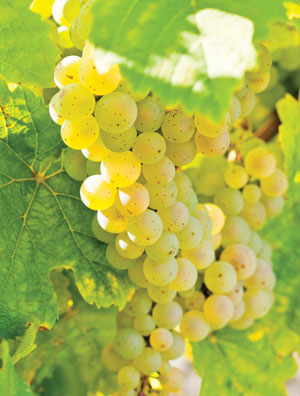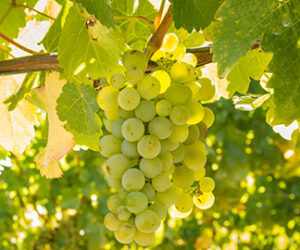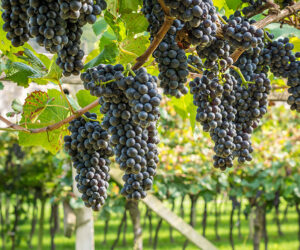 A phrase we’ve often heard in recent years is, “A. B. C. — anything but Chardonnay.” As many consumers set down the Chard and start searching for alternative white wines — and as commercial grape growers try to stay up-to-date with the fickle consumer’s wants — the other premier white varieties are gaining status in the North American retail wine market. Chardonnay is in no danger of losing its status as the world’s number-one white wine, but the door is open for other varieties. And today, one of the oldest whites — Riesling — is being appreciated more and more by consumers and winemakers alike. In fact, Riesling is considered by many connossieurs as the finest white wine in the world because of its potential longevity and the wine’s ability to develop characteristics of individual vineyard sites without losing traditional Riesling traits.
A phrase we’ve often heard in recent years is, “A. B. C. — anything but Chardonnay.” As many consumers set down the Chard and start searching for alternative white wines — and as commercial grape growers try to stay up-to-date with the fickle consumer’s wants — the other premier white varieties are gaining status in the North American retail wine market. Chardonnay is in no danger of losing its status as the world’s number-one white wine, but the door is open for other varieties. And today, one of the oldest whites — Riesling — is being appreciated more and more by consumers and winemakers alike. In fact, Riesling is considered by many connossieurs as the finest white wine in the world because of its potential longevity and the wine’s ability to develop characteristics of individual vineyard sites without losing traditional Riesling traits.
Several years ago, I hosted a wine trip to Germany. On the tour we tasted many German trocken (dry) Riesling wines that were between twenty to thirty years old. Most of them were surprisingly magnificent. Still racy, crisp with excellent fruit and well-rounded with lingering flavors, the older Riesling wines captured the fancy of our tour group, most of whom had never tasted older dry Riesling wines before. The enthusiastic attendees of this German tour can verify the aging potential of German Riesling wines.
Where Riesling is Grown
Riesling, most often considered unique to Germany, also can be found in other countries of Europe, including Italy, France, Austria, Hungary, Russia, Bulgaria and Croatia, and in the central Asian republics. Riesling plantings in Australia are second only to Chardonnay, with over 10,000 acres planted. In New Zealand 1,000 acres are planted and additional acreage continues to be planted.
In California, some 4,000 acres of Riesling are planted and Washington State has about 2,000 acres. The variety’s cold climate hardiness makes it an attractive grape choice in Ontario and British Columbia. Likewise, in the Finger Lakes region of New York, Riesling is a treasured variety.
Riesling is Varied and Versatile
The attractiveness of Riesling wine is its versatility. Varying from the trocken or dry style, to the halb trocken (semi-dry) to eiswein (ice wine), a very sweet late-harvest wine, Riesling offers the consumer and winemaker a wide variety of choices in style.
Riesling is one of the few varieties which is susceptible to Botrytis cinerea (the noble mold), which makes it ideal for lusciously sweet wines made from late harvested grapes. In Germany, the Botrytis cinerea-affected wines occur only a few times a decade and the late- harvested grapes produce super-sweet wines called Beerenauslese (late-harvest berry) and Trockenbeerenauslese (dry, late-harvest berry). And in the years when the late-hanging grapes are frozen by several days of low temperatures [below 20° F (-7° C)], the delicate, delicious, sweet eiswein (ice wine) is made. These late-harvest beauties have been made in other countries under similar conditions. In some countries the frozen conditions have been created by the winemaker, who freezes the very ripe grapes in a commercial freezer and then processes the wine. This process is called cryoextraction. The results have been mixed. Apparently, nature still works best.
Wherever it is made, Riesling wine is recognized for its strong, spicy aroma, often described as honeyed, fruity, or flowery. Riesling also contains a blend of mineral elements derived from the individual vineyard site. The variety is high in monoterpenes (aromatic flavor compounds), up to 50 times more than most other white grape varieties, from which the variety’s raciness and tartness is derived.
The true Riesling (called Rhine, Johannisberg Riesling or white) is noted by the toughness of its wood, which allows it to be cold hardy and able to grow and prosper in cooler climates. Grape ripening is improved with plantings done on sheltered sites.
There are other white grape varieties planted that have assumed the Riesling name, but are not true Rieslings. These grape varieties include Walschriesling, Grey Riesling, Main Riesling and Emerald Riesling (a hybrid developed in 1946 by Dr. Harold P. Olmo of U.C. Davis with the Johannisberg Riesling and the Muscadelle for warm climate growing).
Availability seems to be good for Riesling. California Riesling grapes are available each season, as are fresh grapes from such regions as New York State, Pennsylvania and Ohio, among others. Technology improvements with juice processing now allow for excellent processed Riesling juices to be available year-round. I have been making Riesling for over thirty years. For the past seven years I have not purchased fresh Riesling grapes; instead I have purchased Riesling juice. The convenience of the juice is best appreciated by the home winemaker who has limited time and equipment. Personally, I have not seen any drop-off in quality of my annual Riesling wine by making it with juice rather than fresh grapes. I recommend using Riesling juice to any amateur home winemaker.
Making Riesling
I have talked to numerous amateur and professional winemakers about the winemaking styles of Rieslings. As with most discussions on winemaking, there is always a wide variance of ideas on techniques and practices and each winemaker had his or her own favorite version of the variety. There was one point of agreement among all of the winemakers, and that was that Riesling should never go through malo-lactic fermentation. They all agreed that Riesling should be made in the fresh, crisp, fruity style for best results and that long, cool fermentations were recommended if possible.
When I visited Germany, I mentioned to several German winemakers how wonderful their trocken and halb-trocken Rieslings were and asked why we hadn’t received any of these drier Riesling styles in America. Their responses were all similar: “All you Americans like sweet wines.” We may indeed have an international reputation for the affection of sweet wines, but I think that is changing.
Warren Strong of Bozrah, Connecticut is a full-time pharmacist who is also a part-time grapegrower and amateur home winemaker. His small acreage is mostly Riesling sprinkled with several other varieties. Strong’s claim to fame is his Riesling wine, which is consistently excellent each vintage, as attested to by the many medals and citations his wines have earned through the years. He and his wife own a bed-and-breakfast inn on his property and each guest receives a bottle of his Riesling wine with each booking. According to Strong, his repeat guests always inquire about the complimentary bottle of Riesling wine when they call for a reservation. It’s very popular.
Strong is actually preparing himself to manage a commercial farm winery not too far down the road. “Riesling is my favorite,” he states. “I love the grape and I love the wine and I think my affection for the variety is represented in my wines.”
In our Riesling wine discussions with both amateur and commercial winemakers, the same two yeast strains were constantly mentioned: Red Star Cote des Blancs and Lalvin R2. These varieties are low-foaming and bring out floral and fruity characteristics of the wine, qualities which are popular with Riesling winemakers. If your local winemaking shop doesn’t carry these strains, EC-1118 is an acceptable alternative.
Luke Canotosto of Cranston, Rhode Island, a longtime amateur home winemaker who favors the Riesling grape, makes all of his Riesling wines dry. “I make all of my Rieslings dry because I like them that way. If I have guests who prefer sweeter versions, I just add two tablespoons of my simple syrup mix to each glass and everybody is happy.” Adding one pound (0.45 kg) of sugar to 48 ounces (1.4 L) of hot water makes the mixture. The mixture can be stored in the refrigerator.
The adding of a simple syrup mix or any sweetening agent to a dry finished wine is a practice that many home winemakers use and I’m told that it works. I have never done this so I can’t offer a bonafide recommendation, but it’s easy and maybe worth a try as an experiment. Incidentally, Riesling wine makes an excellent companion to most Oriental dishes and some Tex-Mex dishes.
For those who wish to make Riesling with Riesling juice I’m including the enclosed tried-and-true recipe.
Dry White Wine from Johannisberg Grape Juice
Yield: 5 gallons (19 L)
Ingredients:
5 gallons (19 L) Johannisberg Riesling grape juice
15 Campden tablets (6.6 g) or 2 teaspoons (12.4 g) potassium metabisulfite powder
1 package (5 g) Red Star Cotes des Blanc yeast culture
3 teaspoons (8.8 g) yeast nutrient
Step by Step:
1. Sanitize all equipment.
2. Through a screened funnel, pour the five gallons of Riesling juice into a sanitized fermentation container capable of holding more than five gallons of juice. Use either a plastic, ceramic, steel or glass container.
3. Test the juice for acid and sugar balances and make adjustments, if necessary. Sugar counts should be between 19–22 Brix (1.078–1.090 SG) and the acid range should be between 0.6 to 0.9 percent. Make a yeast starter by pouring approximately four ounces (120 mL) of juice and four ounces (120 mL) of lukewarm water into a bowl. Sprinkle the yeast and yeast nutrient and allow to proliferate for about thirty minutes, then pour the yeast starter into the fermentation container. Stir to mix.
4. Place a clean cotton sheet or paper towel over the fermentation container. If you are using a glass carboy, insert a fermentation cap filled with clean water into the neck of the carboy. Fermentation containers must allow space for foaming during this process but must be protected from foreign matter or bugs. Within a few days the fermentation should start and continue for between seven to twelve days.
5. Once the fermentation begins you should start checking the specific gravity each day with your hydrometer. When the specific gravity gets below 1.000 proceed to the next step. If the specific gravity stays above 1.000, allow the wine to ferment longer, until it reaches the appropriate number. A dry wine will reach a specific gravity of 0.995 or lower.
6. When your specific gravity numbers have been met, it is now time to siphon the wine from the fermentation container with a clean clear plastic hose into a sanitized container (hopefully a five-gallon glass carboy). This procedure is called racking. Help to stabilize the wine by adding five crushed Campden tablets (2.2 g) or one-half teaspoon (3.1 g) potassium metabisulfite powder to the clean carboy before racking. Fill the container up to the bottom of the fermentation lock. If there is not enough wine to fill the carboy, then fill it with similar wine or if it is a minimal amount, it can be filled with water. Place the wine in a cool spot like a root cellar or garage where the temperature will read between 35–45° F (1.7–7.2° C).
7. Let the wine sit in the cool climate for three to four weeks. When the sediment accumulates at the bottom of the carboy, it is time to again rack the wine into a clean container, leaving the sediment behind. This action will help to clear the tartrates and stabilize the wine. At this racking and further rackings add only two crushed Campden tablets (0.88 g) or one-eighth teaspoon (0.7 g) of potassium metabisulfite to the clean carboy before racking; this procedure will halt oxidation and bacterial infection. Two or three more rackings might be necessary to completely clarify the wine.
8. If the wine does not clear, use gelatin, kieselsol or bentonite finings. (If using gelatin, kieselsol or bentonite is necessary, follow the manufacturer’s directions for procedure and quantities.) An additional three or four weeks will be needed to clarify the wine. If a fining agent is necessary, then the wine will have to be filtered before bottling.
9. When the wine is clear, and filtering completed if necessary, it is time to bottle the wine. If you prefer a trocken (dry) Riesling, then bottle the wine and let sit for three months before tasting. If you prefer a Riesling with one to two percent sugar, then test for sugar content by using your hydrometer. Add small amounts of the simple sugar mixture previously mentioned to the wine until the specific gravity reaches 1.015. Or, if you have a Clinitest sugar measuring kit, you can use that to test the sugar content. If sweetening is done then add one-eighth teaspoon (0.7 g) of potassium metabisulfite or two crushed Campden tablets (0.88 g). Two and a half teaspoons (7.5 g) of potassium sorbate must also be added to stop a potential re-fermentation in the bottle. After bottling wait three months before tasting.






